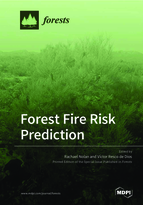Forest Fire Risk Prediction
A special issue of Forests (ISSN 1999-4907). This special issue belongs to the section "Forest Ecology and Management".
Deadline for manuscript submissions: closed (30 November 2020) | Viewed by 65005
Special Issue Editors
Interests: forest fire forecasting; management; pyro-physiology; resprouting; trade-offs
Interests: wildfire; flammability; forests; carbon stocks and fluxes; ecophysiology; ecohydrology; fire ecology; water resources
Special Issues, Collections and Topics in MDPI journals
Special Issue Information
Dear Colleagues,
Globally, fire regimes are being altered by changing climatic conditions and land use changes. This has the potential to drive species extinctions and cause ecosystem state changes, with a range of consequences for ecosystem services. Accurate prediction of the risk of forest fires over short timescales (weeks or months) is required for land managers to target suppression resources in order to protect people, property, and infrastructure, as well as fire-sensitive ecosystems. Over longer timescales, prediction of changes in forest fire regimes is required to model the effect of wildfires on the terrestrial carbon cycle and subsequent feedbacks into the climate system.
This Special Issue of Forests is focused on quantifying and modeling the risk factors of forest fires. We particularly welcome studies that assess the forecasting of forest fire occurrence in relation to (i) fuel load and connectivity; (ii) fuel moisture content (both live and dead); (iii) fire ignition sources; (iv) fire weather or fire weather indices; and (v) any other aspect related to predicting forest fire risk. Both observational and modeling studies are welcome.
Dr. Rachael Nolan
Dr. Víctor Resco de Dios
Guest Editors
Manuscript Submission Information
Manuscripts should be submitted online at www.mdpi.com by registering and logging in to this website. Once you are registered, click here to go to the submission form. Manuscripts can be submitted until the deadline. All submissions that pass pre-check are peer-reviewed. Accepted papers will be published continuously in the journal (as soon as accepted) and will be listed together on the special issue website. Research articles, review articles as well as short communications are invited. For planned papers, a title and short abstract (about 100 words) can be sent to the Editorial Office for announcement on this website.
Submitted manuscripts should not have been published previously, nor be under consideration for publication elsewhere (except conference proceedings papers). All manuscripts are thoroughly refereed through a single-blind peer-review process. A guide for authors and other relevant information for submission of manuscripts is available on the Instructions for Authors page. Forests is an international peer-reviewed open access monthly journal published by MDPI.
Please visit the Instructions for Authors page before submitting a manuscript. The Article Processing Charge (APC) for publication in this open access journal is 2600 CHF (Swiss Francs). Submitted papers should be well formatted and use good English. Authors may use MDPI's English editing service prior to publication or during author revisions.
Keywords
- wildfire
- risk
- flammability
- fuel moisture content
- forests
- fuel load
- fire weather
- ignitions







